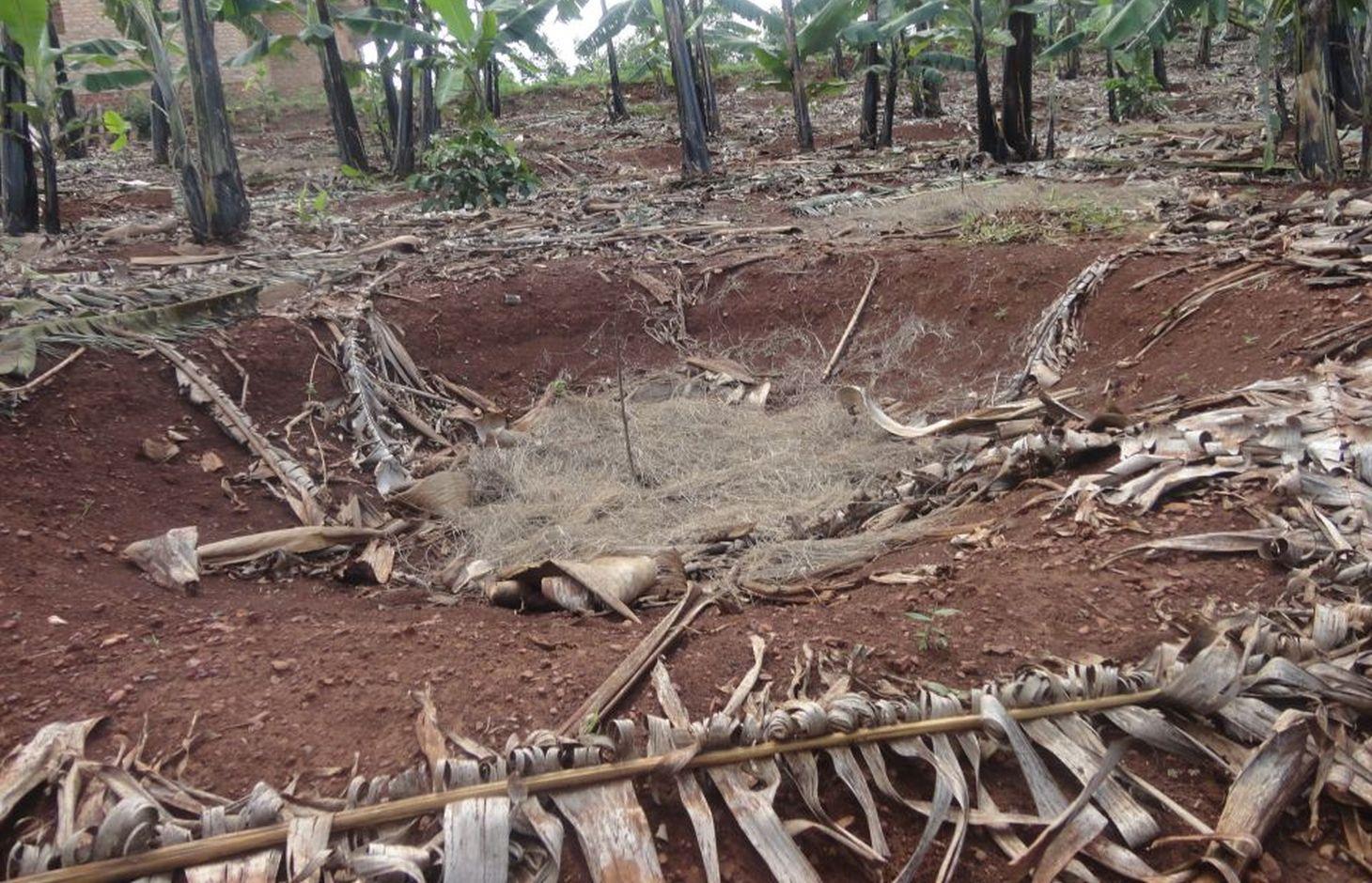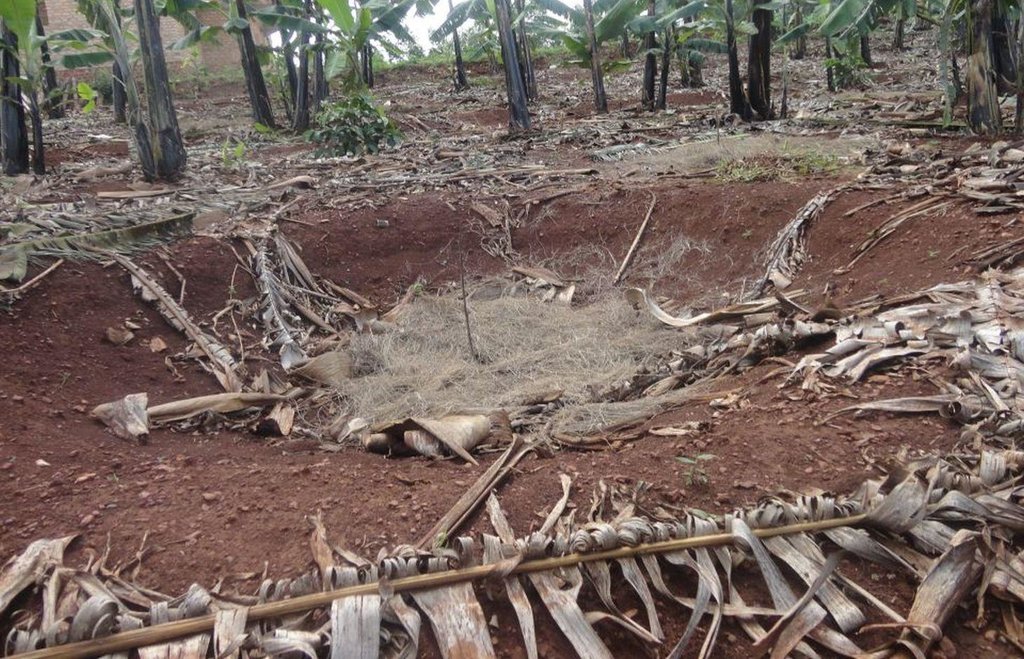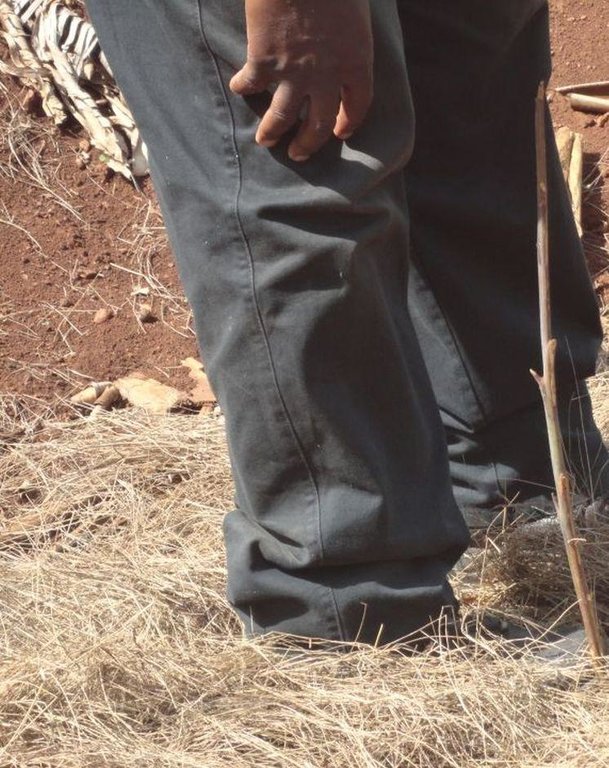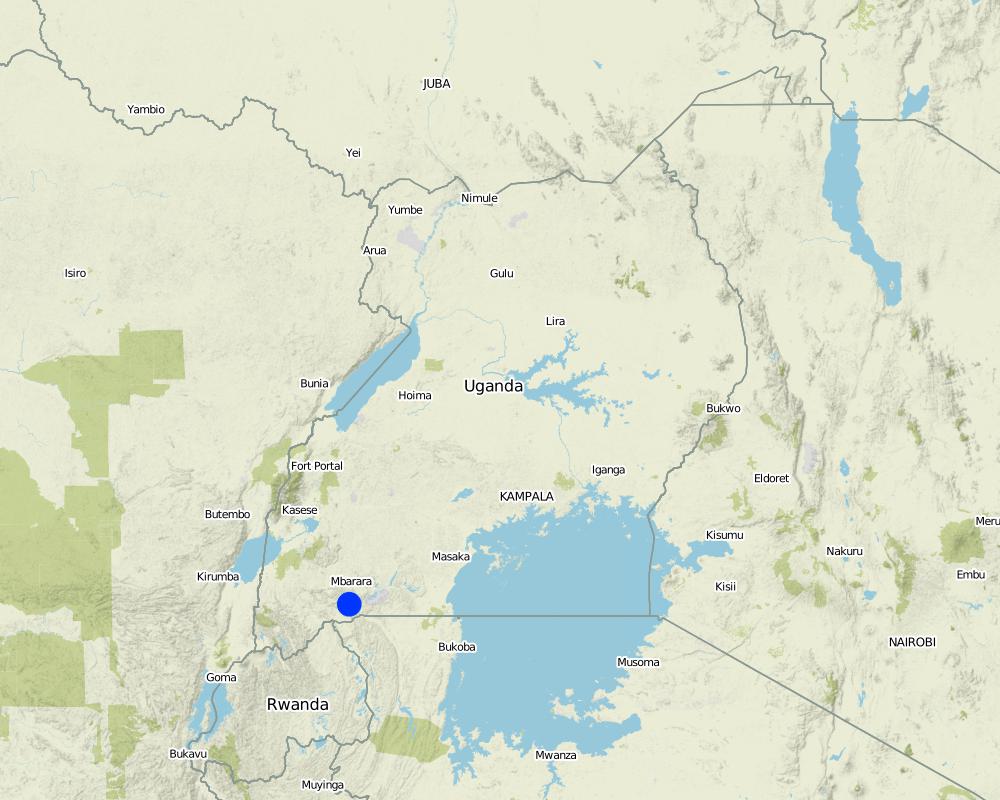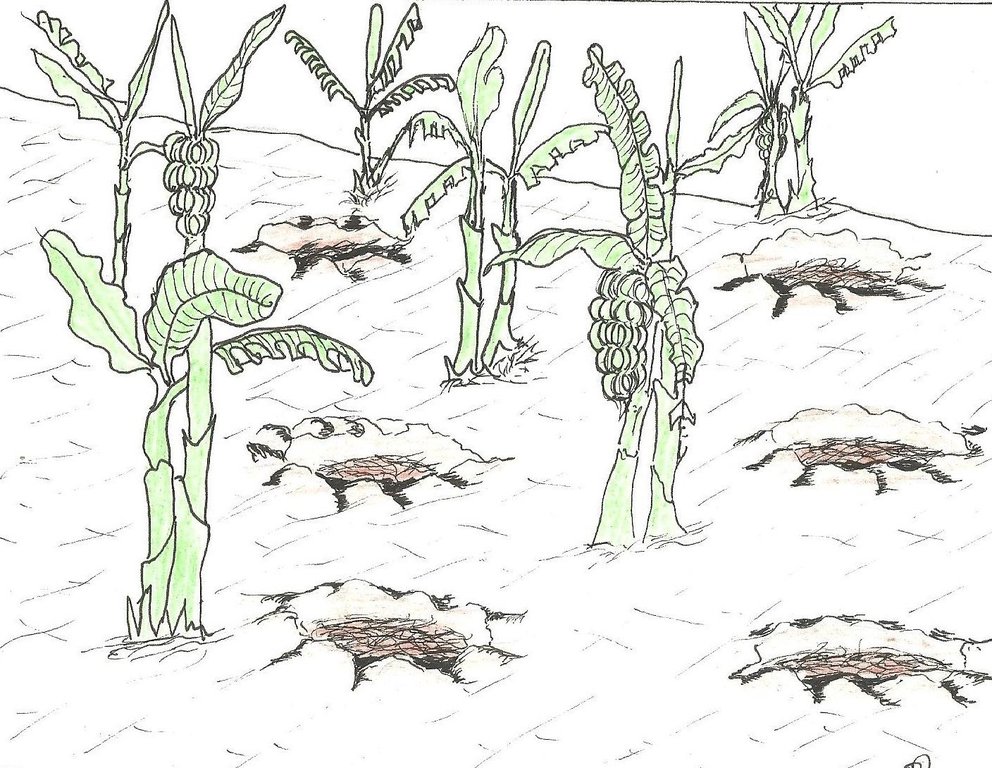Planting pits for soil fertilisation and moisture improvement [អ៊ូហ្គង់ដា]
- ការបង្កើត៖
- បច្ចុប្បន្នភាព
- អ្នកចងក្រង៖ Wilson Bamwerinde
- អ្នកកែសម្រួល៖ –
- អ្នកត្រួតពិនិត្យច្រើនទៀត៖ Fabian Ottiger, Alexandra Gavilano
EBISANIYA (Runyankore language)
technologies_1587 - អ៊ូហ្គង់ដា
ពិនិត្យមើលគ្រប់ផ្នែក
ពង្រីកមើលទាំងអស់ បង្រួមទាំងអស់1. ព័ត៌មានទូទៅ
1.2 ព័ត៌មានលម្អិតពីបុគ្គលសំខាន់ៗ និងស្ថាប័នដែលចូលរួមក្នុងការវាយតម្លៃ និងចងក្រងឯកសារនៃបច្ចេកទេស
អ្នកជំនាញឯកទេស SLM:
អ្នកជំនាញឯកទេស SLM:
អ្នកជំនាញឯកទេស SLM:
ឈ្មោះគម្រោងដែលបានចងក្រងឯកសារ/ វាយតម្លៃលើបច្ចេកទេស (បើទាក់ទង)
The Transboundary Agro-ecosystem Management Project for the Kagera River Basin (GEF-FAO / Kagera TAMP )ឈ្មោះអង្គភាពមួយ (ច្រើន) ដែលបានចងក្រងឯកសារ/ វាយតម្លៃបច្ចេកទេស (បើទាក់ទង)
Food and Agriculture Organization of the United Nations (FAO) - ប្រទេសអ៊ីតាលី1.3 លក្ខខណ្ឌទាក់ទងទៅនឹងការប្រើប្រាស់ទិន្នន័យដែលបានចងក្រងតាមរយៈ វ៉ូខេត
អ្នកចងក្រង និង(បុគ្គលសំខាន់ៗ)យល់ព្រមទទួលយកនូវលក្ខខណ្ឌនានាទាក់ទងទៅនឹងការប្រើប្រាស់ទិន្នន័យដែលបានចងក្រងតាមរយៈវ៉ូខេត:
បាទ/ចា៎
2. ការពណ៌នាពីបច្ចេកទេស SLM
2.1 ការពណ៌នាដោយសង្ខេបពីបច្ចេកទេស
និយមន័យបច្ចេកទេស:
Planting pits in banana plantation filled with a mixture of manure, organic material and soil, to improve soil moisture and fertility and to enhance crop production and famer's income.
2.2 ការពណ៌នាលម្អិតពីបច្ចេកទេស
ការពណ៌នា:
The planting pits are established between banana stems and filled with organic vegetative material mixed with decomposing manure to form a reservoir of nutrients for a long run. On gentle slopes covered with extensive banana plantations, the planting pits are dug at the center of banana stands. Before estbalishment of this technology, only the composting process was available for the conversion of organic domestic waste into manure. However, compost manure takes slightly longer to produce and is more bulky than conservation troughs making the latter easier to adopt. The technology can be applied to annual cropland as well. Application of the technology improves banana bunch size and plantation yield by over 300%.
Purpose of the Technology: The main objective is to improve soil fertility. The planting pits also check runoff thereby reducing soil erosion, improving moisture infiltration and retention, and enabling the plantation to withstand the dry months. Cabbages, beans and other high value vegetables can be grown directly on top of the trough.
Establishment / maintenance activities and inputs: The planting pits are established using simple tools such as the hand hoe, spade, panga and wheelbarrow. The hoe is used to dig up the soil and soften it. The soil is then scooped out using a spade, to create a bowl-shaped trough. The panga is used to chop the remains of harvested bananas (stems and leaves) which are then, carried to the troughs using a wheel barrow. The planting pit is 0.45 m to 0.60 m deep depending on the amount of manure available and 0.6 m wide. Each trough is about 0.60 m from the nearest banana stand. It is filled with chopped banana stems, followed by a layer of manure and then covered with mulch to prevent excessive evaporation of moisture. The planting pit is then covered with soil. After 3 to 4 months, the vigor of the banana stems improves. If the trough is opened by digging, roots are observed to have grown through the walls of the planting pit from all directions.
During the rainy season, the trough slowly fills with sediment from surface erosion. Weeding at the trough is done by uprooting the weeds using hands or a hand hoe.
Natural / human environment: Over time, the banana stands grow towards the trough. To maintain the distance between the stands, the suckers nearest to the trough are pruned.
2.3 រូបភាពនៃបច្ចេកទេស
2.5 ប្រទេស/តំបន់/ទីតាំងកន្លែង ដែលបច្ចេកទេសត្រូវបានអនុវត្ត និងបានគ្រប់ដណ្តប់ដោយការវាយតម្លៃនេះ
ប្រទេស:
អ៊ូហ្គង់ដា
តំបន់/រដ្ឋ/ខេត្ត:
Uganda
បញ្ជាក់បន្ថែមពីលក្ខណៈនៃទីតាំង:
Mbarara
មតិយោបល់:
Boundary points of the Technology area: -0.86269 30.62587; -0.86275 30.62622; -0.86279 30.62631; -0.86405 30.62522; -0.86393 30.62539, -0.86387 30.62503
Total area covered by the SLM Technology is 0.04 km2.
Map
×2.6 កាលបរិច្ឆេទនៃការអនុវត្ត
ប្រសិនបើមិនច្បាស់ឆ្នាំ សូមបញ្ជាក់កាលបរិច្ឆេទដែលប្រហាក់ប្រហែល:
- តិចជាង 10ឆ្នាំមុន (ថ្មី)
2.7 ការណែនាំពីបច្ចេកទេស
សូមបញ្ជាក់តើបច្ចេកទេសត្រូវបានណែនាំឱ្យអនុវត្តដោយរបៀបណា:
- តាមរយៈការបង្កើតថ្មីរបស់អ្នកប្រើប្រាស់ដី
មតិយោបល់ (ប្រភេទនៃគម្រោង ។ល។):
In 2012, Kagera TAMP introduced the Farmer Field School methodology. The members of these schools have been experimenting on several SLM technologies since then and the troughs are one of the successful innovations
3. ចំណាត់ថ្នាក់នៃបច្ចេកទេស SLM
3.1 គោលបំណងចម្បង (១ ឬច្រើន) នៃបច្ចេកទេសនេះ
- ធ្វើឱ្យប្រសើរឡើងនូវផលិតកម្ម
- កាត់បន្ថយ, បង្ការ, ស្តារឡើងវិញនូវការធ្លាក់ចុះគុណភាពដី
- បង្កើតផលប្រយោជន៍សេដ្ឋកិច្ច
3.2 ប្រភេទដីប្រើប្រាស់មួយប្រភេទ (ច្រើនប្រភេទ) ដែលបានអនុវត្តបច្ចេកទេស

ដីដាំដំណាំ
- ដំណាំប្រចាំឆ្នាំ
- ដំណាំរយៈពេលវែង (មិនមែនឈើ)
ដំណាំប្រចាំឆ្នាំ - បញ្ជាក់ប្រភេទដំណាំ:
- ធញ្ញជាតិ - ពោត
- ពពួកសណ្តែក - សណ្តែកបារាំង
- ពពួកសណ្តែក - គ្រាប់ហោឡាំងតាវ
- ឬស/ដំណាំមើម - ដំឡូងបារាំង
ដំណាំរយៈពេលវែង (មិនមែនឈើ) - បញ្ជាក់ប្រភេទដំណាំ:
- ចេក/plantain/abaca
ចំនួនសារដែលដាំដំណាំក្នុងមួយឆ្នាំ:
- 2
សូមបញ្ជាក់:
Longest growing period in days: 120 Longest growing period from month to month: February to May Second longest growing period in days: 90 Second longest growing period from month to month: September to November
មតិយោបល់:
Major land use problems (compiler’s opinion): The light, sandy loam soil on a hilly slope has very little capacity to hold water. The soils are dry a few days after it rains. The banana plantation therefore suffers two problems: inadequate soil water for plant growth and low nutrient retention. The problem of soil erosion is critical in the area but is addressed more adequately by fanya ju retention trenches stabilized with Napier grass strips.
Major land use problems (land users’ perception): Low productivity of the land compared to past seasons.
3.4 ការផ្គត់ផ្គង់ទឹក
ការផ្គត់ផ្គង់ទឹកនៅកន្លែងអនុវត្តបច្ចេកទេស:
- ទឹកភ្លៀង
3.5 ក្រុម SLM ដែលបច្ចេកទេសស្ថិតនៅក្នុង
- ការគ្រប់គ្រងជីជាតិដីតាមបែបចម្រុះ
3.6 វិធានការ SLM ដែលបញ្ចូលនូវបច្ចេកទេស

វិធានការក្សេត្រសាស្ត្រ
- A7: ផ្សេងៗ

វិធានការរចនាស័ម្ពន្ធ
- S4: កម្រិតភ្លឺ រណ្តៅ
មតិយោបល់:
Main measures: structural measures
Specification of other agronomic measures: Manure application (supp.
3.7 កំណត់ប្រភេទនៃការធ្លាក់ចុះគុណភាពដីសំខាន់ៗដែលបច្ចេកទេសនេះបានដោះស្រាយ

ការធ្លាក់ចុះសារធាតុគីមីក្នុងដី
- Cn: ការថយចុះជីជាតិ និងកាត់បន្ថយបរិមាណសារធាតុសរីរាង្គ (មិនកើតឡើងដោយការហូរច្រោះទេ)
មតិយោបល់:
Main type of degradation addressed: Cn: fertility decline and reduced organic matter content
Main causes of degradation: soil management (No manure was being applied to replenish nutrients inspite of continuous banana harvesting)
3.8 ការពារ កាត់បន្ថយ ឬស្តារឡើងវិញនៃការធ្លាក់ចុះគុណភាពដី
បញ្ជាក់ពីគោលដៅរបស់បច្ចេកទេស ដែលផ្តោតទៅការធ្លាក់ចុះគុណភាពដី:
- ការការពារការធ្លាក់ចុះគុណភាពដី
- ការកាត់បន្ថយការធ្លាក់ចុះគុណភាពដី
មតិយោបល់:
Main goals: mitigation / reduction of land degradation
Secondary goals: prevention of land degradation
4. បច្ចេកទេសជាក់លាក់ សកម្មភាពអនុវត្ត ធាតុចូល និងថ្លៃដើម
4.1 គំនូសបច្ចេកទេសនៃបច្ចេកទេសនេះ
លក្ខណៈពិសេសនៃបច្ចេកទេស (ទាក់ទងនឺងគំនូរបច្ចេកទេស):
Conservation troughs (0.4-0.6 m deep) are partially filled with a mixture of manure, undecomposed banana stems and other organic matter to add organic matter into the soil. They also capture rainfall runoff and help to maintain suitable soil moisture. The conservation trough should be dug about 0.6 m from banana plant so that the heat produced during decay does not affect the plant.
Location: Rubagano, Mwizi, Mbarara district. Uganda
Date: 29-Nov-2013
Technical knowledge required for field staff / advisors: low (Self explanatory)
Technical knowledge required for land users: moderate (Basic training required on the construction methodology e.g. location selection, recommended dimentions of the trough (depth))
Main technical functions: increase in organic matter, increase in nutrient availability (supply, recycling,…), increase of infiltration, increase / maintain water stored in soil, water harvesting / increase water supply
Secondary technical functions: improvement of topsoil structure (compaction), improvement of subsoil structure (hardpan)
Retention/infiltration ditch/pit, sediment/sand trap
Vertical interval between structures (m): n/a
Spacing between structures (m): 3
Depth of ditches/pits/dams (m): 0.6
Width of ditches/pits/dams (m): 2
Length of ditches/pits/dams (m): 2
Height of bunds/banks/others (m): n/a
Width of bunds/banks/others (m): n/a
Length of bunds/banks/others (m): n/a
Reshaping surface
Vertical interval between structures (m): n/a
Spacing between structures (m): n/a
Depth of ditches/pits/dams (m): 3
Width of ditches/pits/dams (m): 0.6
Length of ditches/pits/dams (m): 2
Height of bunds/banks/others (m): 2
Width of bunds/banks/others (m): n/a
Length of bunds/banks/others (m): n/a
Construction material (earth): Troughs are developed by excavating soil; soil mixed with manure is used to fill the pit partially.
Construction material (stone): n/a
Construction material (wood): n/a
Construction material (concrete): n/a
Construction material (other): n/a
Slope (which determines the spacing indicated above): n/a%
If the original slope has changed as a result of the Technology, the slope today is: n/a%
Lateral gradient along the structure: n/a%
Specification of dams/ pans/ ponds: Capacity n/am3
Catchment area: n/am2
Beneficial area: n/am2
Slope of dam wall inside: n/a%;
Slope of dam wall outside: n/a%
Dimensions of spillways: n/am
Other specifications: n/a
For water harvesting: the ratio between the area where the harvested water is applied and the total area from which water is collected is: 1:n/a
ឈ្មោះអ្នកនិពន្ធ:
Byonabye Proscovia, Kagera TAMP, Kabale District
4.2 ព័ត៌មានទូទៅដែលពាក់ព័ន្ធនឹងការគណនាធាតុចូល និងថ្លៃដើម
ផ្សេងៗ/ រូបិយប័ណ្ណជាតិ (បញ្ជាក់):
UGX
បើពាក់ព័ន្ធសូមកំណត់អត្រាប្តូរប្រាក់ពីដុល្លាទៅរូបិយប័ណ្ណតំបន់ (ឧ. 1 ដុល្លារ = 79.9 រៀលនៃរូបិយប័ណ្ណប្រេស៊ីល) ៖ 1 ដុល្លារ =:
2500,0
កំណត់ថ្លៃឈ្នួលជាមធ្យមនៃការជួលកម្លាំងពលកម្មក្នុងមួយថ្ងៃ:
4.00
4.3 សកម្មភាពបង្កើត
| សកម្មភាព | រយៈពេល (រដូវកាល) | |
|---|---|---|
| 1. | Measuring and marking pit positions | Wet season |
| 2. | Excavating pits | Wet season |
| 3. | Mixing top soil with animal manure, filling mixture into pits, putting domestic and field organic residues into pits, covering pits | Wet season |
4.4 ថ្លៃដើម និងធាតុចូលដែលត្រូវការសម្រាប់ការបង្កើតបច្ចេកទេស
| បញ្ជាក់ពីធាតុចូល | ឯកតា | បរិមាណ | ថ្លៃដើមក្នុងមួយឯកតា | ថ្លៃធាតុចូលសរុប | % នៃថ្លៃដើមដែលចំណាយដោយអ្នកប្រើប្រាស់ដី | |
|---|---|---|---|---|---|---|
| កម្លាំងពលកម្ម | Labour | ha | 1,0 | 44,0 | 44,0 | 100,0 |
| សម្ភារៈ | Tools | ha | 1,0 | 7,0 | 7,0 | |
| ជី និងសារធាតុពុល | Compost/manure | ha | 1,0 | 40,0 | 40,0 | 100,0 |
| ថ្លៃដើមសរុបក្នុងការបង្កើតបច្ចេកទេស | 91,0 | |||||
| ថ្លៃដើមសរុបក្នុងការបង្កើតបច្ចេកទេសគិតជាដុល្លារ | 0,04 | |||||
មតិយោបល់:
Duration of establishment phase: 2 month(s)
4.5 សកម្មភាពថែទាំ
| សកម្មភាព | ពេលវេលា/ ភាពញឹកញាប់ | |
|---|---|---|
| 1. | Weeding by hand | Wet season |
| 2. | Addition of manure and residues | Once a year |
4.6 កំណត់ថ្លៃដើមសម្រាប់ការថែទាំ/ សកម្មភាពរបស់បច្ចេកទេស (ក្នុងរយៈពេលមួយឆ្នាំ)
| បញ្ជាក់ពីធាតុចូល | ឯកតា | បរិមាណ | ថ្លៃដើមក្នុងមួយឯកតា | ថ្លៃធាតុចូលសរុប | % នៃថ្លៃដើមដែលចំណាយដោយអ្នកប្រើប្រាស់ដី | |
|---|---|---|---|---|---|---|
| កម្លាំងពលកម្ម | Labour | ha | 1,0 | 10,0 | 10,0 | 100,0 |
| សម្ភារៈ | Tools | ha | 1,0 | 4,0 | 4,0 | 100,0 |
| ជី និងសារធាតុពុល | Compost/manure | ha | 1,0 | 20,0 | 20,0 | 100,0 |
| ថ្លៃដើមសរុបសម្រាប់ការថែទាំដំណាំតាមបច្ចេកទេស | 34,0 | |||||
| ថ្លៃដើមសរុបសម្រាប់ការថែទាំដំណាំតាមបច្ចេកទេសគិតជាដុល្លារ | 0,01 | |||||
មតិយោបល់:
Machinery/ tools: hand hoe, wheel barrow
The calculations were made for the rainy season of September to November, 2013.
4.7 កត្តាសំខាន់បំផុតដែលមានឥទ្ធិពលដល់ការចំណាយ
ពណ៌នាពីកត្តាប៉ះពាល់ចម្បងៗទៅលើថ្លៃដើម:
Availability of labour and animal manure are the most important factors affecting cost of the establishment activities. To reduce cost of labour it is recommended to apply Farmer Field Schools approach. To reduce cost of manure farmers can produce their own farmyard manure, e.g. by implementing zero-grazing technology.
5. លក្ខណៈបរិស្ថានធម្មជាតិ និងមនុស្ស
5.1 អាកាសធាតុ
បរិមាណទឹកភ្លៀងប្រចាំឆ្នាំ
- < 250 មម
- 251-500 មម
- 501-750 មម
- 751-1,000 មម
- 1,001-1,500 មម
- 1,501-2,000 មម
- 2,001-3,000 មម
- 3,001-4,000 មម
- > 4,000 មម
លក្ខណៈពិសេស/ មតិយោបល់លើរដូវភ្លៀង:
1400 mm spread over 2 seasons
តំបន់កសិអាកាសធាតុ
- មានភ្លៀងមធ្យម
Thermal climate class: tropics. Located at the Equator. A good supply of rain much of the year, but plenty of sunshine too
5.2 សណ្ឋានដី
ជម្រាលជាមធ្យម:
- រាបស្មើ (0-2%)
- ជម្រាលតិចតួច (3-5%)
- មធ្យម (6-10%)
- ជម្រាលខ្ពស់បន្តិច (11-15%)
- ទីទួល (16-30%)
- ទីទួលចោត (31-60%)
- ទីទួលចោតខ្លាំង (>60%)
ទម្រង់ដី:
- ខ្ពង់រាប
- កំពូលភ្នំ
- ជម្រាលភ្នំ
- ជម្រាលទួល
- ជម្រាលជើងភ្នំ
- បាតជ្រលងភ្នំ
តំបន់តាមរយៈកម្ពស់ :
- 0-100 ម
- 101-500 ម
- 501-1,000 ម
- 1,001-1,500 ម
- 1,501-2,000 ម
- 2,001-2,500 ម
- 2,501-3,000 ម
- 3,001-4,000 ម
- > 4,000 ម
បញ្ជាក់ថាតើបច្ចេកទេសនេះត្រូវបានអនុវត្តន៍នៅក្នុង:
- មិនពាក់ព័ន្ធទាំងអស់
មតិយោបល់ និងបញ្ចាក់បន្ថែមអំពីសណ្ឋានដី :
Altitudinal zone: 1501-2000 m a.s.l. (1715 to 1740 m a.s.l.)
Landforms: Hill slopes (ranked 1, concave) and ridges (ranked 2, convex)
Slopes on average: Hilly (Where the technology has been applied so far is on hilly slopes (< 30%) but the adjacent slopes where the technology is planned next is quite steep (> 45%))
5.3 ដី
ជម្រៅដីជាមធ្យម:
- រាក់ខ្លាំង (0-20 សម)
- រាក់ (21-50 សម)
- មធ្យម (51-80 សម)
- ជ្រៅ (81-120 សម)
- ជ្រៅខ្លាំង (> 120 សម)
វាយនភាពដី (ស្រទាប់លើ):
- គ្រើម/ មានពន្លឺ (ខ្សាច់)
សារធាតុសរីរាង្គនៅស្រទាប់ដីខាងលើ:
- មធ្យម (1-3%)
បើអាចសូមភ្ជាប់ការពណ៌នាពីដីឱ្យបានច្បាស់ ឬព័ត៌មានដែលអាចទទួលបាន ឧ. ប្រភេទដី, pH ដី/ ជាតិអាស៊ីត, សមត្ថភាពផ្លាស់ប្តូរកាចុង, វត្តមាននីត្រូសែន, ភាពប្រៃ ។ល។:
Soil depth on average: Shallow (The soils are generally shallow)
Soil fertility: Low
Topsoil organic matter: Medium (Mulching had already introduced topsoil organic matter)
Soil drainage/infiltration: Good
Soil water storage capacity: Medium
5.4 ទឹកដែលអាចទាញមកប្រើប្រាស់បាន និងគុណភាពទឹក
នីវ៉ូទឹកក្រោមដី:
> 50 ម
ទឹកលើដីដែលអាចទាញយកប្រើប្រាស់បាន:
មិនមាន/ គ្មាន
គុណភាពទឹក (មិនបានធ្វើប្រត្តិកម្ម):
ទឹកពិសារដែលគ្មានគុណភាព (តម្រូវឱ្យមានការសំអាត)
មតិយោបល់ និងលក្ខណៈពិសេសផ្សេងៗទៀតលើគុណភាព និងបរិមាណទឹក :
Ground water table: >50 m (Boreholes have been sank before to great lengths but have invariably dried up)
Availability of surface water: Poor/none (Available only as trapped runoff behind rocky formations, but soon dries up)
Water quality (untreated): Poor drinking water (treatment required, runoff)
5.5 ជីវៈចម្រុះ
ភាពសម្បូរបែបនៃប្រភេទ:
- កម្រិតមធ្យម
5.6 លក្ខណៈនៃអ្នកប្រើប្រាស់ដីដែលអនុវត្តបច្ចេកទេស
ទីផ្សារនៃប្រព័ន្ធផលិតកម្ម:
- ពាក់កណ្តាលពាណិជ្ជកម្ម (ផ្គត់ផ្គង់ខ្លួនឯង/ ពាណិជ្ជកម្ម)
ចំណូលក្រៅកសិកម្ម:
- តិចជាង 10% នៃចំណូល
កម្រិតជីវភាព:
- មធ្យម
ឯកជន ឬក្រុម:
- ធ្វើខ្លួនឯង/ គ្រួសារ
កម្រិតប្រើប្រាស់គ្រឿងយន្ត:
- ប្រើកម្លាំងពលកម្ម
យេនឌ័រ:
- ស្ត្រី
- បុរស
សូមបញ្ជាក់ពីលក្ខណៈពាក់ព័ន្ធផ្សេងទៀតអំពីអ្នកប្រើប្រាស់ដី:
Land users applying the Technology are mainly common / average land users
Difference in the involvement of women and men: n/a
Population density: 100-200 persons/km2
Annual population growth: 3% - 4%
and own 20% of the land.
and own 30% of the land.
40% of the land users are average wealthy and own 40% of the land.
and own 10% of the land.
Off-farm income specification: There has been an improvement in yields which translate into money generated per hectare. However, the farmers applying the technology have not yet diversified into other enterprises.
Level of mechanization: Manual work (Hand hoe, spade, wheel barrow)
Market orientation: Mixed (Surplus has grown to such a level that the commercial component has become inevitable)
5.7 ទំហំផ្ទៃដីជាមធ្យមនៃដីប្រើប្រាស់ដោយអ្នកប្រើប្រាស់ដី ក្នុងការអនុវត្តបច្ចេកទេស
- < 0.5 ហិកតា
- 0.5-1 ហិកតា
- 1-2 ហិកតា
- 2-5 ហិកតា
- 5-15 ហិកតា
- 15-50 ហិកតា
- 50-100 ហិកតា
- 100-500 ហិកតា
- 500-1,000 ហិកតា
- 1,000-10,000 ហិកតា
- > 10,000 ហិកតា
តើផ្ទៃដីនេះចាត់ទុកជាទំហំកម្រិតណាដែរ ខ្នាតតូច មធ្យម ឬខ្នាតធំ (ធៀបនឹងបរិបទតំបន់)?
- ខ្នាតតូច
5.8 ភាពជាម្ចាស់ដី កម្មសិទ្ធប្រើប្រាស់ដី និងកម្មសិទ្ធប្រើប្រាស់ទឹក
ភាពជាម្ចាស់ដី:
- ឯកជន មិនមានកម្មសិទ្ធ
កម្មសិទ្ធិប្រើប្រាស់ដី:
- ឯកជន
កម្មសិទ្ធប្រើប្រាស់ទឹក:
- អាស្រ័យផលសេរី (មិនមានការកំណត់)
- ឯកជន
មតិយោបល់:
Individual access to water rights is relatively new with the introduction of water harvesting.
5.9 ការប្រើប្រាស់សេវាកម្ម និងហេដ្ឋារចនាសម្ព័ន្ធ
សុខភាព:
- មិនល្អ
- មធ្យម
- ល្អ
ការអប់រំ:
- មិនល្អ
- មធ្យម
- ល្អ
ជំនួយបច្ចេកទេស:
- មិនល្អ
- មធ្យម
- ល្អ
ការងារ (ឧ. ការងារក្រៅកសិដ្ឋាន):
- មិនល្អ
- មធ្យម
- ល្អ
ទីផ្សារ:
- មិនល្អ
- មធ្យម
- ល្អ
ថាមពល:
- មិនល្អ
- មធ្យម
- ល្អ
ផ្លូវ និងការដឹកជញ្ជូន:
- មិនល្អ
- មធ្យម
- ល្អ
ទឹកផឹក និងអនាម័យ:
- មិនល្អ
- មធ្យម
- ល្អ
សេវាកម្មហិរញ្ញវត្ថុ:
- មិនល្អ
- មធ្យម
- ល្អ
6. ផលប៉ះពាល់ និងការសន្និដ្ឋាន
6.1 ផលប៉ះពាល់ក្នុងបរិវេណអនុវត្តបច្ចេកទេសដែលកើតមាន
ផលប៉ះពាល់លើសេដ្ឋកិច្ចសង្គម
ផលិតផល
ផលិតកម្មដំណាំ
គុណភាពមុន SLM:
8 Kg
គុណភាពក្រោយ SLM:
25 Kg
មតិយោបល់/ ការបញ្ជាក់:
Bunch of bananas is bigger and heavier at harvest
ហានិភ័យនៃភាពបរាជ័យរបស់ផលិតកម្ម
គុណភាពមុន SLM:
20%
គុណភាពក្រោយ SLM:
67%
មតិយោបល់/ ការបញ្ជាក់:
During the dry season or extended drought periods, only about 20% of the banana stands would have a fruiting stem; now well over two thirds of the stands do.
ចំណូល និងថ្លៃដើម
ការចំណាយលើធាតុចូលកសិកម្ម
ចំណូលក្នុងកសិដ្ឋាន
គុណភាពមុន SLM:
80 US$
គុណភាពក្រោយ SLM:
200 US$
មតិយោបល់/ ការបញ្ជាក់:
Monthly harvests for sale have increased from 20 to over 50 bunches
បន្ទុកការងារ
ផលប៉ះពាល់ទៅលើវប្បធម៌សង្គម
សន្តិសុខស្បៀង/ ភាពគ្រប់គ្រាន់ខ្លួនឯង
គុណភាពមុន SLM:
50%
គុណភាពក្រោយ SLM:
100%
មតិយោបល់/ ការបញ្ជាក់:
Whereas extended drought posed food insecurity, this is no longer the case
Improved livelihoods and human well-being
មតិយោបល់/ ការបញ្ជាក់:
The earning power has increased greatly. Children are going to school because tuition fees are no longer burdensome and health needs are easily met. The farmers practicing the technology report making some savings from their incomes unlike before.
ផលប៉ះពាល់ទៅលើអេកូឡូស៊ី
វដ្តទឹក/លំហូរ
រំហួត
ដី
សំណើមដី
វដ្តនៃសារធាតុចិញ្ចឹម/ការទទួលបាន
សារធាតុសរីរាង្គដី/ការបូនក្រោមដី
6.3 ភាពប្រឈម និងភាពរួសនៃបច្ចេកទេសទៅនឹងការប្រែប្រួលអាកាសធាតុ និងគ្រោះអាកាសធាតុ/ គ្រោះមហន្តរាយ (ដែលដឹងដោយអ្នកប្រើប្រាស់ដី)
ការប្រែប្រួលអាកាសធាតុ
ការប្រែប្រួលអាកាសធាតុ
| រដូវកាល | កើនឡើង ឬថយចុះ | លក្ខណៈឆ្លើយតបនៃបច្ចេកទេសទៅនឹងការប្រែប្រួលអាកាសធាតុ | |
|---|---|---|---|
| សីតុណ្ហភាពប្រចាំឆ្នាំ | កើនឡើង | ល្អ |
គ្រោះអាកាសធាតុ (មហន្តរាយ)
គ្រោះមហន្តរាយធម្មជាតិ
| លក្ខណៈឆ្លើយតបនៃបច្ចេកទេសទៅនឹងការប្រែប្រួលអាកាសធាតុ | |
|---|---|
| ព្យុះភ្លៀងតាមតំបន់ | ល្អ |
| ព្យុះកំបុតត្បូងតាមតំបន់ | ល្អ |
គ្រោះមហន្តរាយអាកាសធាតុ
| លក្ខណៈឆ្លើយតបនៃបច្ចេកទេសទៅនឹងការប្រែប្រួលអាកាសធាតុ | |
|---|---|
| រាំងស្ងួត | ល្អ |
គ្រោះមហន្តរាយទឹក
| លក្ខណៈឆ្លើយតបនៃបច្ចេកទេសទៅនឹងការប្រែប្រួលអាកាសធាតុ | |
|---|---|
| ទឹកជំនន់ទូទៅ (ទន្លេ) | មិនស្គាល់ |
ផលវិបាកដែលទាក់ទងនឹងបរិយាកាសផ្សេងៗទៀត
ផលវិបាកដែលទាក់ទងនឹងបរិយាកាសផ្សេងៗទៀត
| លក្ខណៈឆ្លើយតបនៃបច្ចេកទេសទៅនឹងការប្រែប្រួលអាកាសធាតុ | |
|---|---|
| កាត់បន្ថយពេលដាំដុះ | ល្អ |
មតិយោបល់:
The advantages of the technology to cropland are to be found underground. Therefore the technology is protected against most natural adversities above ground.
6.4 ការវិភាគថ្លៃដើម និងអត្ថប្រយោជន៍
តើផលចំណេញ និងថ្លៃដើមត្រូវបានប្រៀបធៀបគ្នាយ៉ាងដូចម្តេច (ទស្សនៈរបស់អ្នកប្រើប្រាស់ដី)?
រយៈពេលខ្លី:
វិជ្ជមាន
រយៈពេលវែង:
វិជ្ជមានខ្លាំង
តើផលចំណេញ និងការថែទាំ/ ជួសជុលត្រូវបានប្រៀបធៀបគ្នាយ៉ាងដូចម្តេច (ទស្សនៈរបស់អ្នកប្រើប្រាស់ដី)?
រយៈពេលខ្លី:
វិជ្ជមានខ្លាំង
រយៈពេលវែង:
វិជ្ជមានខ្លាំង
មតិយោបល់:
Costs at establishment are the only ones involved. There are no maintenance costs involved though pits need to be re-established every 2-3 years
6.5 ការទទួលយកបច្ចេកទេស
បើអាច សូមបញ្ជាក់ពីបរិមាណ (ចំនួនគ្រួសារ និង/ ឬតំបន់គ្របដណ្តប់):
22
ក្នុងចំណោមគ្រួសារទាំងអស់ដែលបានអនុវត្តបច្ចេកទេស តើមានប៉ុន្មានគ្រួសារដែលចង់ធ្វើដោយខ្លួនឯង ដោយមិនទទួលបានសម្ភារៈលើកទឹកចិត្ត/ប្រាក់ឧបត្ថម្ភ?:
- 91-100%
មតិយោបល់:
Comments on acceptance with external material support: It is a farmer initiative and no support has been received for the adoption of this technology.
100% of land user families have adopted the Technology without any external material support
22 land user families have adopted the Technology without any external material support
Comments on spontaneous adoption: This is a farmer field school initiative and the district facilitator for Kagera TAMP (and also an Agricultural officer of the local government) provided guidance on positioning the pits for maximum utility.
There is a strong trend towards spontaneous adoption of the Technology
Comments on adoption trend: Noticing the results in only 3 seasons, the other farmers (not members of farmer field school) are also adopting the technology.
6.7 ភាពខ្លាំង/ គុណសម្បត្តិ/ ឱកាសនៃបច្ចេកទេស
| ភាពខ្លាំង/ គុណសម្បត្តិ/ ឱកាស ទស្សនៈរបស់បុគ្គលសំខាន់ៗ |
|---|
|
The technology requires the use of only the simplest of farm tools such as a hand hoe, a spade and a wheel barrow. How can they be sustained / enhanced? Dissemination of the the technology through regular community meetings and a local language newsletter |
|
Demonstration of benefits is achieved quite quickly and therefore adoption by farmers is good. How can they be sustained / enhanced? Emphasize technology at farmer field school demonstration plots |
|
Technology bears similar benefits to composting but with a shorter list of activities How can they be sustained / enhanced? Encourage adoption through demonstration |
|
Since the technology utilizes stem cuttings, whole stems are harvested reducing the risk of pests and diseases especially banana bacteria, that would be harbored by exposed rotting stems How can they be sustained / enhanced? Knowledge dissemination through regular community meetings and local language newsletter |
6.8 ភាពខ្សោយ/ គុណវិបត្តិ/ ហានិភ័យនៃបច្ចេកទេស និងវិធីសាស្ត្រដោះស្រាយ
| ភាពខ្សោយ/ គុណវិបត្តិ/ ហានិភ័យ ទស្សនៈរបស់អ្នកចងក្រងឬបុគ្គលសំខាន់ៗ | តើបច្ចេកទេសទាំងនោះបានដោះស្រាយបញ្ហាដូចម្តេច? |
|---|---|
| The technology is labor intensive | Farmer Field Schools bring farmers together in a community level effort |
| The technology requires livestock manure in a predominantly cultivator community | Introduce zero-grazing livestock for manure production |
7. ឯកសារយោង និងវេបសាយ
7.1 វិធីសាស្ត្រ/ ប្រភពនៃព័ត៌មាន
7.2 ឯកសារយោងដែលបានចេញផ្សាយ
ចំណងជើង អ្នកនិពន្ធ ឆ្នាំ ISBN:
Kagera TAMP project website
មានប្រភពមកពីណា? ថ្លៃដើមប៉ុន្មាន?
http://www.fao.org/nr/kagera/en/
ការតភ្ជាប់ និងម៉ូឌុល
ពង្រីកមើលទាំងអស់ បង្រួមទាំងអស់ការតភ្ជាប់
គ្មានការតភ្ជាប់
ម៉ូឌុល
គ្មានម៉ូឌុល


